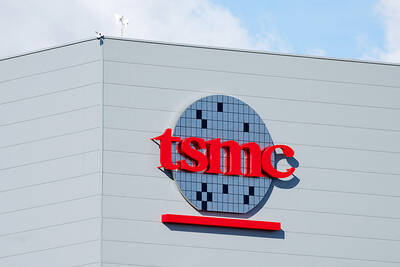The Taiwan Institute of Economic Research (TIER, 台灣經濟研究院) yesterday raised its economic growth forecast for the nation to 5.03 percent, citing a global economic recovery, which it said would boost the nation’s exports and domestic demand.
That represented an increase of 0.73 percentage points from its forecast in January and is the first to forecast growth of more than 5 percent.
The Directorate-General of Budget, Accounting and Statistics in late February forecast that GDP would grow 4.64 percent this year, while the central bank last month projected a 4.53 percent increase.

Photo: CNA
Despite the uncertainty over the global economy due to the COVID-19 pandemic, the technology sector has not suffered any ill-effects, allowing Taiwanese manufacturing activity to expand, TIER said.
The upgraded economic growth forecast was based on rising domestic demand and exports in Taiwan, TIER president Chang Chien-yi (張建一) told reporters.
If the global economy continues to recover, TIER might consider raising its forecast for Taiwan again, he said.
TIER forecasts that the Taiwanese economy would post quarterly growth of 6.01 percent, 7.35 percent, 3.64 percent and 3.43 percent.
The higher GDP growth forecast for this year also reflects a relatively low baseline last year due to the COVID-19 pandemic, said Gordon Sun (孫明德), director of TIER’s Economic Forecasting Center.
Other major factors include contract chipmaker Taiwan Semiconductor Manufacturing Co’s (TSMC, 台積電) massive investment plans and robust demand for emerging technologies, such as 5G applications in the information and communications technology industry.
TSMC, the world’s largest contract chipmaker, last week said that it plans to spend US$30 billion of its capital expenditure to expand production capacity and upgrade its technologies to maintain its lead over its competitors.
Taiwan’s private investment is expected to grow 5.02 percent this year, while capital formation would increase by 4.43 percent, TIER said, raising its growth forecasts from 4.83 percent and 4.14 percent respectively.
Telecoms are also working to build their 5G networks, while many companies are investing in the nation’s offshore wind and solar energy development projects, TIER said.
Private consumption is expected to increase 4.35 percent this year, TIER said, raising its forecast by 0.22 percentage points, on the back of a thriving manufacturing sector and a booming equity market.
The think tank also hiked it growth forecast for Taiwan’s exports of merchandise and services, from 4.87 percent to 5.64 percent, and for imports, from 4.47 percent to 4.87 percent.
It raised its projection for growth in the consumer price index, from 1 percent to 1.3 percent, saying that while global raw material prices are on the rise, it remains to be seen whether the world economy would face inflationary pressure.
Meanwhile, business sentiment in the local manufacturing sector weakened slightly last month, with the composite index for the manufacturing sector dropping 0.39 from the previous month to 105.73.
The composite index for the property industry fell 2.68 from February to 106.6 last month, while the index for the service sector rose 1.25 to 100.96, TIER said.

Taiwan Semiconductor Manufacturing Co (TSMC, 台積電) secured a record 70.2 percent share of the global foundry business in the second quarter, up from 67.6 percent the previous quarter, and continued widening its lead over second-placed Samsung Electronics Co, TrendForce Corp (集邦科技) said on Monday. TSMC posted US$30.24 billion in sales in the April-to-June period, up 18.5 percent from the previous quarter, driven by major smartphone customers entering their ramp-up cycle and robust demand for artificial intelligence chips, laptops and PCs, which boosted wafer shipments and average selling prices, TrendForce said in a report. Samsung’s sales also grew in the second quarter, up

LIMITED IMPACT: Investor confidence was likely sustained by its relatively small exposure to the Chinese market, as only less advanced chips are made in Nanjing Taiwan Semiconductor Manufacturing Co (TSMC, 台積電) saw its stock price close steady yesterday in a sign that the loss of the validated end user (VEU) status for its Nanjing, China, fab should have a mild impact on the world’s biggest contract chipmaker financially and technologically. Media reports about the waiver loss sent TSMC down 1.29 percent during the early trading session yesterday, but the stock soon regained strength and ended at NT$1,160, unchanged from Tuesday. Investors’ confidence in TSMC was likely built on its relatively small exposure to the Chinese market, as Chinese customers contributed about 9 percent to TSMC’s revenue last

With this year’s Semicon Taiwan trade show set to kick off on Wednesday, market attention has turned to the mass production of advanced packaging technologies and capacity expansion in Taiwan and the US. With traditional scaling reaching physical limits, heterogeneous integration and packaging technologies have emerged as key solutions. Surging demand for artificial intelligence (AI), high-performance computing (HPC) and high-bandwidth memory (HBM) chips has put technologies such as chip-on-wafer-on-substrate (CoWoS), integrated fan-out (InFO), system on integrated chips (SoIC), 3D IC and fan-out panel-level packaging (FOPLP) at the center of semiconductor innovation, making them a major focus at this year’s trade show, according

DEBUT: The trade show is to feature 17 national pavilions, a new high for the event, including from Canada, Costa Rica, Lithuania, Sweden and Vietnam for the first time The Semicon Taiwan trade show, which opens on Wednesday, is expected to see a new high in the number of exhibitors and visitors from around the world, said its organizer, SEMI, which has described the annual event as the “Olympics of the semiconductor industry.” SEMI, which represents companies in the electronics manufacturing and design supply chain, and touts the annual exhibition as the most influential semiconductor trade show in the world, said more than 1,200 enterprises from 56 countries are to showcase their innovations across more than 4,100 booths, and that the event could attract 100,000 visitors. This year’s event features 17